How to file your taxes with Swiss and foreign securities in 2024
| Updated: |(Disclosure: Some of the links below may be affiliate links)
One question I often get is how to file taxes with stocks and dividends. This becomes especially popular when we add foreign stocks and dividends to the mix.
Many people are afraid of investing because they think it will make filing their taxes complicated. But in practice, it is not complicated to file taxes even with a large ETF portfolio.
In this article, we see how to file your taxes with Swiss Stocks and dividends, which is very simple. And with U.S. Stocks and dividends, which is slightly more complicated.
Filing taxes
In Switzerland, taxes are different for each canton. Each canton has its software and forms to complete your tax form. However, most of the forms are very similar and have similar names. So, if you can file your taxes in one canton, you should not have many issues filing them in another.
Since taxes differ in each canton in Switzerland, I need to take an example. So, I will take Fribourg as an example with the Fritax 2020 software. You can use this example to file your taxes for your canton. The concepts should be the same for each canton, but the software to fill them will differ slightly.
Some of the Swiss tax apps are better than others. I have not tested many of them, but from what I have seen, Fritax is probably average. It is not always intuitive, but it is relatively easy to use.
Unfortunately, Fritax is not available in English. So I will use the French version for my screenshots. The forms will be the same in German as well.
If you do not know why I am using U.S. ETFs, you may want to learn about the advantages of U.S. ETFs. They are related to how you will file your taxes with U.S. securities.
Swiss Securities
First, we start to see how to declare Swiss securities. These are the securities that are subject to the Swiss dividend withholding taxes. Indeed, the Swiss tax office will withhold 35% of the dividends. Your broker will do this directly.
In your tax declaration, you will have a form to enter all your assets (bank accounts, bonds, stocks, and lottery gains). In my French software, this is called “Etat des titres”, which translates to “Status of the securities”.
Here is the form before filling it:
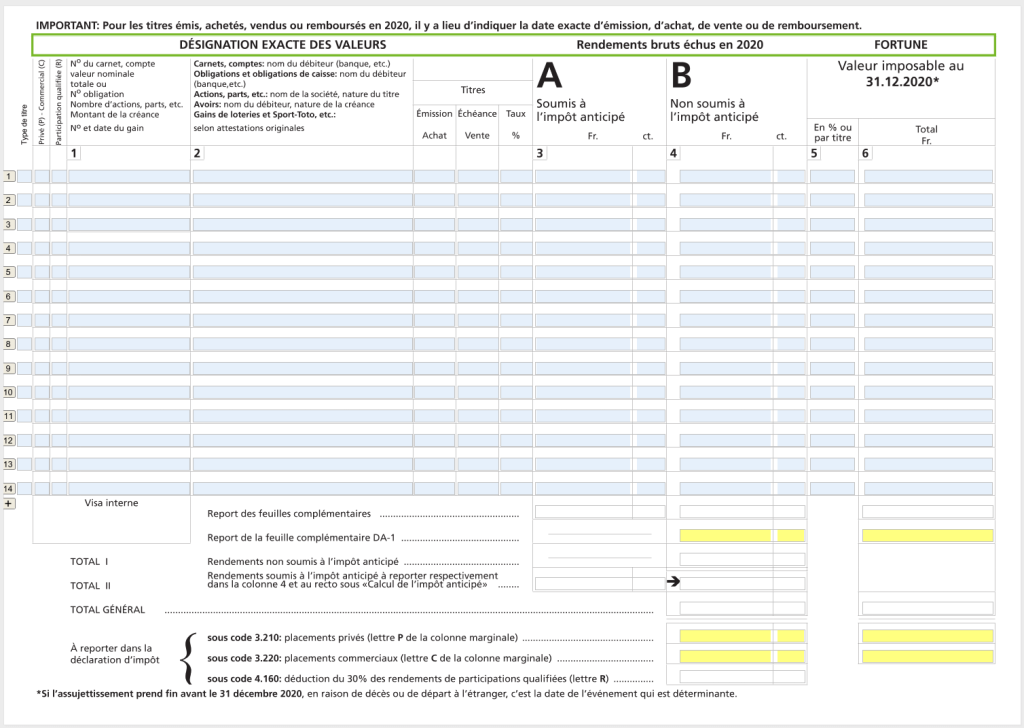
In this form, you must list all of your Swiss securities, whether stocks or ETFs. Since I am recommending investments in ETFs, I will take an ETF as an example. But you would do exactly the same with a stock. For example, I will use CHSPI, the Swiss ETF I use in my portfolio.
You must indicate this is a security (choice 3) in the first column on each line. You must then indicate that this is a private asset (choice P) in the second column.
Then, you can press the “Listes des cours” (Lists of prices) to search for the prices of a security. This assistant will help you with your dividends and prices. You can enter the ISIN number of your ETF and press search (Chercher). For instance, the ISIN number of CHSPI is CH0237935652. You can find the ISIN number of each ETF on the website of the fund provider.
Then, you will see all the taxable income for this security. You can enter the number of shares, the buy date, and the taxable value, and the taxable dividend will be calculated for you. For instance:
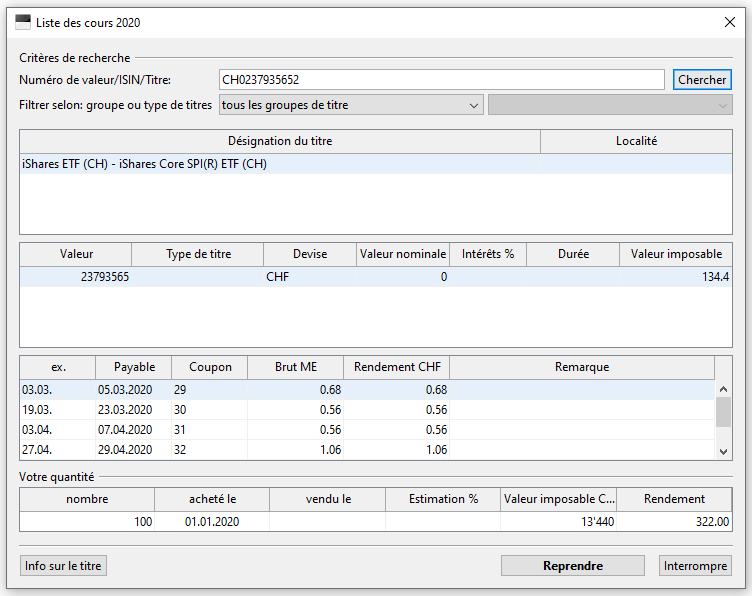
The date will be considered to compute the dividends for this security. If you enter a date that is after some dividends have been issued, they will not be considered. And they will automatically compute the taxable wealth with the security value at the end of the year.
Here is an example of what this could look like.

The totals are automatically done at the end of the form. And these values are propagated into the rest of the forms.
If you already have securities before the beginning of the year, you have two options. If you file your taxes right after the year without losing your tax declaration, you can keep all the buy operations from the previous year. Or you can use the total number of shares at the beginning of the year with a single entry and a date like the last year of the previous year. I have already done that in the past, and I have never had any issues.
If you have sold securities during the year, you must also declare them. You can use a purchase date and sold date to let the software compute how many dividends you received before selling the shares. In that case, the software will automatically set the taxable value to zero.
Using ICTax
Unfortunately, not every Swiss taxes software allows you to get all these numbers inside the app. So, in this case, you will have to use the ICTax website. This is the reference for all the official end-of-year prices and currency conversions to file your taxes. One good thing is that this website is available in English, contrary to the tax software.
You can go to the website and search for the ISIN again:
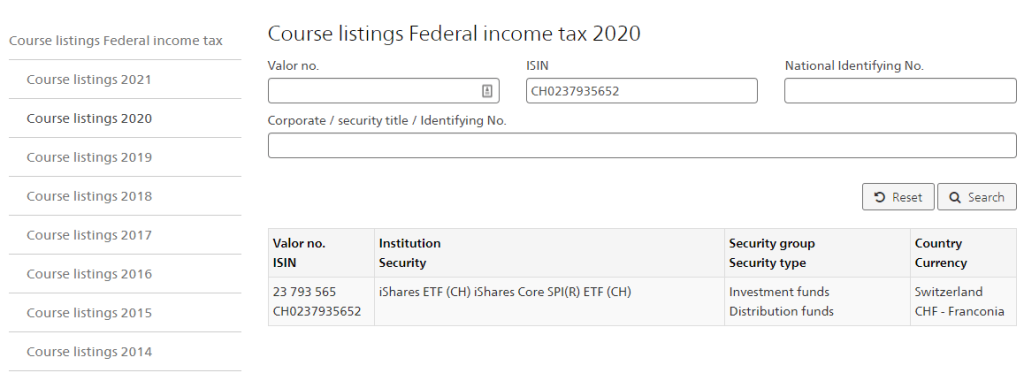
And then, you can click on the ETF of your choosing. After that, you must do the same as before with the tax software. You will be able to enter the number of shares and purchase date. The website will automatically compute the tax value and the gross return. You can then copy these values directly into your tax declaration.
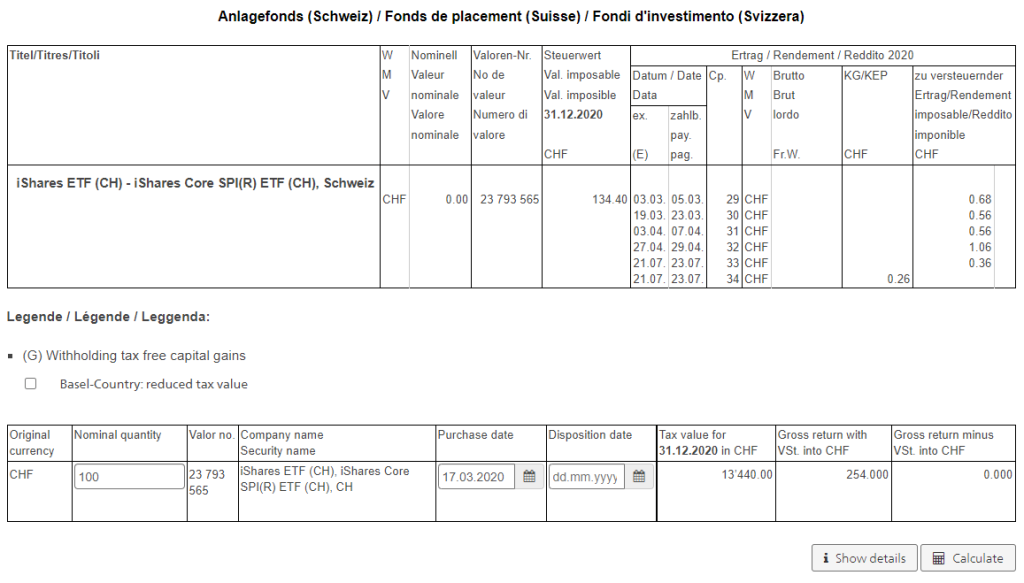
It is much less practical to file taxes like this than having the software do it for you. But in any case, it should not take you long to complete your Swiss securities.
It is also a good reason to keep your trading limited to a few ETFs. If you are buying many securities during the entire year, you will have to enter many lines. But it is not as complicated as many people believe.
If your ETF is not on ICTax, you can ask them to add it to the system. But most well-known ETFs should already be there. I have never had an issue so far.
U.S. ETFs / Securities
For U.S. ETFs and securities, it can get a little more complicated because there are a few possible cases.
First, it will depend on which broker you are using. If you are using a Swiss broker, you will pay two deductions:
- 15% withheld by the Swiss broker
- 15% directly withheld at source by the Internal Revenue Service (IRS)
If you are using a broker like Interactive Brokers, you will only see the IRS’s direct deduction. This is a foreign tax.
You need to use the DA-1 form to claim back foreign tax. You need to use the R-US 164 form to claim back Swiss withholding if you use a Swiss broker.
These forms are attachments to the form we covered in the previous section. And they are extremely similar. The difference will be in setting the percentages that you can claim back.
If you use other foreign securities, the idea remains the same, except that the percentages will differ. You will have to find the percentages for both columns for your situation.
In this case, Fritax did an excellent job since they put DA-1 and R-US 164 together. Therefore, there is only a single form to fill for foreign securities. This is a great idea!
Here is the empty combined DA-1 / R-US 164 form:
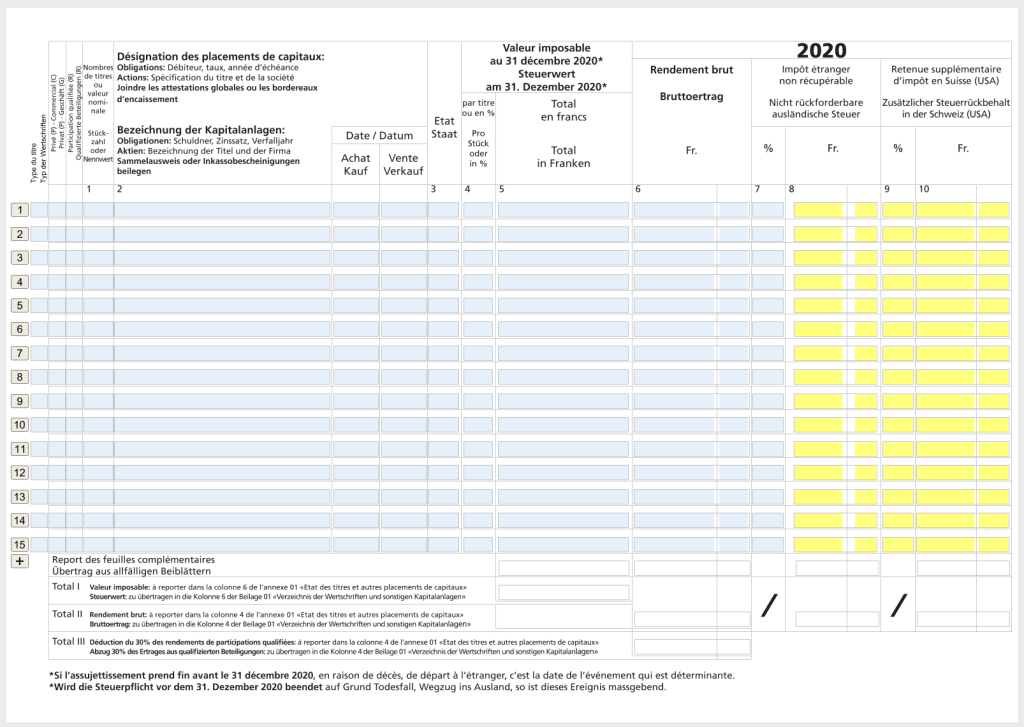
As we can see, it is extremely similar to the previous form. And it works exactly the same way. You must still select that this is an action and part of your private net worth. Then, you can use the same assistant to get all the tax information by pressing the “Liste de cours” button on top of the form.
They have all the information, even for U.S. ETFs, such as Vanguard Total World (VT). Here is an example of how to fill it with VT:
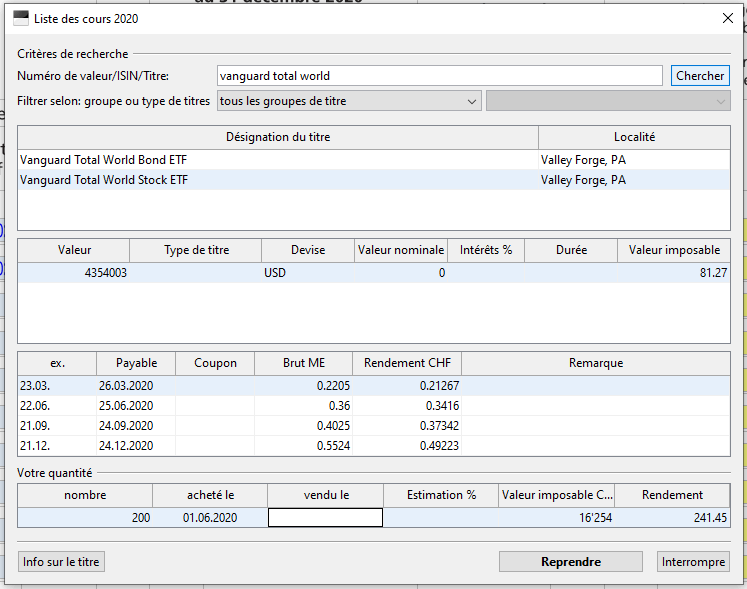
Once you have filled a line, you still need to select the country in column 3. This will be the US in our case.
Then, you need to update columns 7 and 9 with the percentages for your case. If you only fill the DA-1 form (with Interactive Brokers), you must set column 7 to the value 15. If you are filling the R-US 164 form (with a Swiss broker, for instance), you must set column 9 to the value 15.
Then, the tool will automatically compute how much taxes were withheld in both cases. And Fritax will automatically fill in the total.
Here is a filled DA-1 form with both sides filled:

If you use Interactive Brokers and only pay 15% of dividends withholding, you can change column 9 to the value 0.
All the other details are the same as for the Swiss securities, so you can look at the previous sections to get all the information. But with the Fritax software, it is not that bad to file your taxes with foreign securities. As you can see, the DA-1 and R-US 164 forms are almost the same as the standard securities form.
It is important to note that the DA-1 deduction is generally only applied if you have more than 100 CHF in foreign withholding. It does not change how you file your taxes, but knowing this may avoid a surprise when receiving your tax decision.
Using ICTax
If your tax software does not support getting the values directly from it, you can use the ICTax website for foreign securities too. It will give you all the dividends in CHF and the tax value of your securities at the end of the fiscal year.
This will be done exactly like we did for Swiss securities. For instance, you can search for Vanguard Total World on the website:
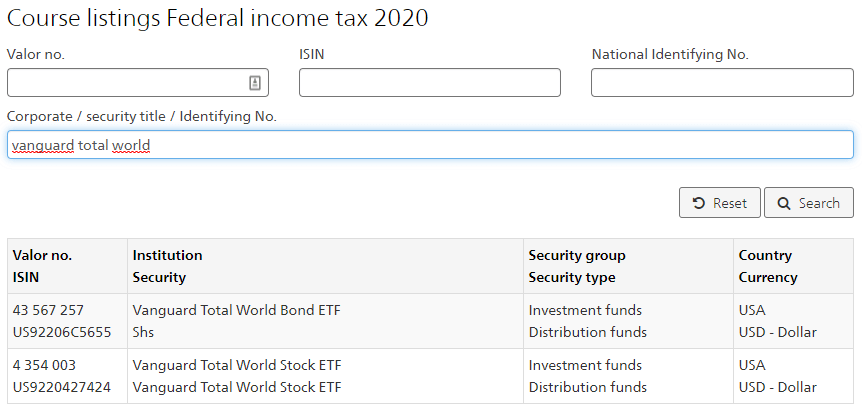
Make sure you choose the Stock version and not the bond version (unless you have both, of course). And then, you can fill it up like before. For instance:
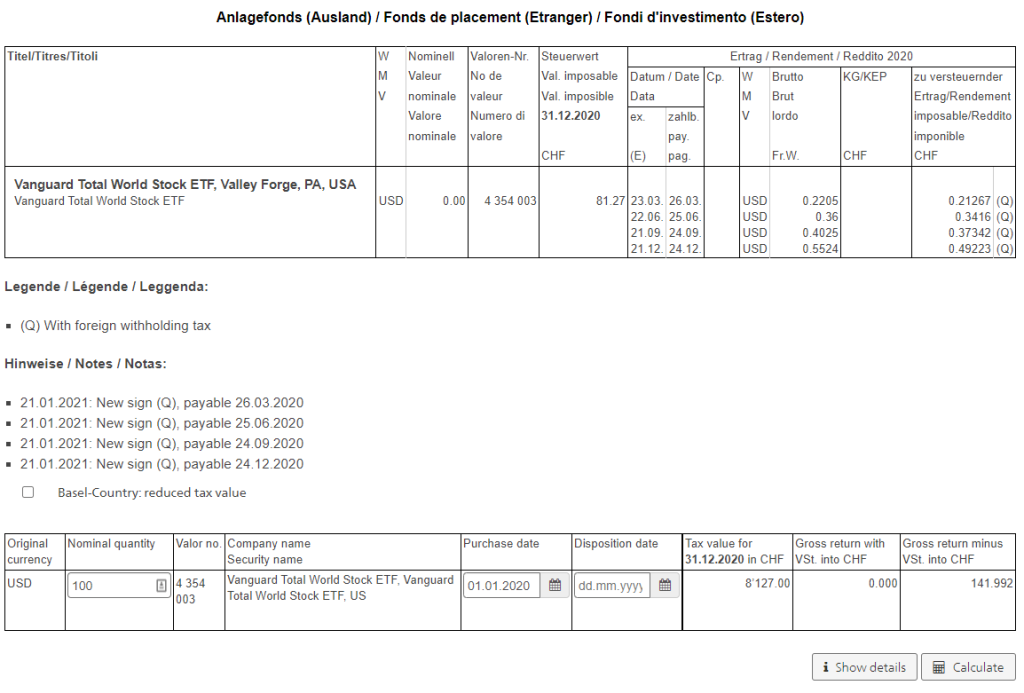
Then, you will only have to copy these values into the DA-1 or R-US 164 form and select the correct withholding percentages. It is not more complicated than for Swiss securities.
Attachments
The tax office will request documents attesting to your dividends, capital gains, and net worth.
Some Swiss brokers will propose some special documents for taxes. And some people believe that only these reports are valid. But that is not correct. Even foreign brokers have documents that Swiss tax offices accept.
For instance, I use an annual activity statement report with Interactive Brokers. This contains all operations, all dividends, and the status of my shares at the end of the year. I have never had any issue with that. You can get this from the Reports tab. In there, you can generate an activity statement for the entire year.
Conclusion
There you have it! Following these simple steps, you can file taxes with Swiss and foreign securities! It is not as complicated as many people believe.
Even for U.S. Securities, it is not complicated. You must fill out an extra form (DA-1) in the best case and two in the worst case (DA-1 and R-US 164), but these forms are almost the same as for Swiss securities. So, I do not think this is a big deal.
If you are wondering why we need to fill all these lines, it is for the system to compute exactly how much you got from dividends. Since dividends are taxed as income, this must be precise. And only by indicating each buy and sell date will you get a precise amount.
Hopefully, this will help you file your taxes with securities.
If you want more tax information, I have an in-depth guide about Swiss taxes.
Download this e-book and optimize your finances and save money by using the best financial services available in Switzerland!
Download The FREE e-bookRecommended reading
- More articles about Investing Fundamentals
- More articles about Investing
- Margin Loans – Borrow money from your broker
- The Simple Path to Wealth Book Review
- 13 Awesome Stock Market Facts that will surprise you!

Thank you so much for the detailed explanation, it was very useful for me!
I have only a question that it is not clear to me.
If the ETF is US, can you confirm we fill directly the DA-1 form and not the Wertschriftenverzeichnis?
When I do that in Zurich, the system tells me that “Die total beantragte ausl. Quellensteuer ist kleiner als CHF 100 und es kann daher kein Antrag auf Anrechnung der ausl. Quellensteuer gestellt werden. Bitte löschen Sie die Titel aus dem Formular DA-1 und erfassen diese neu im Wertschriften- und Guthabenverzeichnis.”
Hi
Yes, that sounds correct if Wertschriftenverzeichnis means list of securities.
And yes, there are some minimums in some cantons for how much you can get back.
Hi Baptiste,
John again. For some reason I cannot reply to comments, nothing happens when I click reply (the URL just adds “/#comment-39337” but I cannot reply). So I will reply here, and feel free to move it if possible.
Thank you for your answer! The “Montant de l’impôt étranger en CHF” field seems to be mandatory. It wouldn’t let me enter 0. Should I just enter the same value I entered for the US withholding tax further down?
Hi John,
Thanks for letting me know. I will check the comments system!
Then maybe that’s total of foreign withholding. So, I would also try to enter the same value. Just double-check that you are not double-claiming the withholding :)
The nested comments system should be fixed now!
Yep, it’s working!
Thanks for all the answers. This article and the comments section is super rich!
So yes it seems to be the way. It did not double-claim the withholding :)
John
Dear Baptiste,
may I ask you what is exactly Interactive Brokers “annual activity statement report”? How can I get/create it?
Thank you,
Milan
If you go into Reports, you can generate activity statements for any periods of time and you can choose the entire year, making it a yearly activity statement with everything you did on your account during the year.
Hi Baptiste!
I am using Vaud’s online tax declaration tool (VaudTax), and I have a few questions about the securities part.
I will start with a screenshot so you can see what I’m talking about: https://ibb.co/HpVdhpY
I use IBKR to buy mostly VT (and some CHSPI). In the securities section of VaudTax online, they ask twice about “tax”. One is “Montant de l’impôt étranger en CHF”, and the other is further down and is called “Montant de la retenue supplémentaire USA en CHF”. I’m guessing the latter is the Withholding tax which I can easily find in my IBKR annual report, but what is the first one? Where do I find the corresponding values?
My second question is about the “Pays de l’institution bancaire dans laquelle sont détenues les actions ou parts sociales” / “Pays de l’institution bancaire ou de juridiction pour les sites en ligne (Ex: Swissquote)”. Is that IBKR (if so, would it be UK?)? Or does it depend on each ETF (so in the case of VT, it would be USA)?
Thanks!
John
Hi John,
For an US ETF, you should only have the second one “Montant de la retenue supplémentaire USA en CHF”. In some other cases, you would have both, but the US ETF is simple in that you should only have the 15% withhold at source by IB for the IRS.
I am really not sure about the second question, we don’t have anything like this in Fribourg. But since they mention Swissquote, I would expect that to be IBKR in your case and UK indeed for the country. I don’t think you have to find the domicile of the ETF.
Dear Baptiste,
I have followed your guide to fill in the DA-1 for TAX returns with IBKR and US-domiciliated ETF (btw really Thanks for your guide, it is amazingly helpful). I am a Swiss Investor, and do not have anything related to US (no citizenship, and so on). Today I received from IBKR the Form 1042-S. If I understood well this is a document filled by IBKR for the IRS of USA.
Now I wonder, what should I do with it?
Should we use it for Tax Declaration in Switzerland to have back our Tax at sources for Dividends?
Should we send it to IRS? (This would be very strange to me, as I guess we have to declare taxes only in Switzerland).
Thanks a lot for the answer :)
Hi As,
It’s correct. It’s the tax form suited for your taxes in the US. You don’t have anything to do with it. I have never used it myself.
Hi poor Swiss thank you for this article.
It’s my first year when I will submit securities of my investment in world VT etf. I was under the impression that all I have to do is submit the tax forms provided by interactive broker that are the dividend report and fx income worksheet provided in the tax form section. And especially because I get help with submitting my taxes. Will this suffice too or I still have to go in the tax system of my canton basel stadt to put the details as you describe above? Thank you for your feed back on this.
Hi Jay,
Normally, every person that pays tax (not at source) should fill the full details.
If you are using a tax advisor, he may do that for you I guess.
Good morning Baptist, thank you for this valuable information.
I still don’t understand why is important to detail every transaction. I can see they are detailed in my annual activity statement report already.
So, my questions are?
1- how does the tax office calculs the gross yield exactly? with p&l from the ink statement or the mark to market? and what happens in case of loss during 2022?
2-do we have to pay taxes on us securities capital gains or in us dividends? (I have understood no).
3- is it mandatory to fill up all the buys or its ok to send to the tax office the broker annual statement? or maybe declare your gross positions as for 31.12.2022?
Thank you so much for the guidance…
It’s important for the tax office to be able to find exactly how much dividends you got. It’s also important to distinguish between professional investors and standard investors. They will also calculate capital gains if you are a professional investor. You will pay taxes on any dividend, regardless of the country.
Hi Baptiste,
I don’t understand the difference between forms R-US 164 and DA-1. In the canton of Vaud, we have both separate forms. Which of the forms must be used to declare VT- Vanguard Total with Interactive Brokers?
Thanks for your help!
R-US 164 should be used for American withholding.
How does the claim back work?
Let’s say that I have CHF 1000 in “Rendement brut” (column 8) in FriTax. With IB, I put 15 in column 7 and 0 in column 9. So I’d have CHF 150 in column 8 and CHF 0 in column 10.
Then in total II on the same page, I’ll have CHF 1000 which is reported to “Etat des titres”. So I’ll be taxed on those CHF 1000.- by Swiss taxes. Am I correct?
Where is the 15% that I already paid in foreign tax deducted?
Hi Steve,
You will indeed be taxed as income on the 1000 CHF, but the 150 CHF will be deducted from the final amount of taxes.
It works the same as the withholding on your bank account interest.
Hello Baptiste,
Very informative article and it’s great to see you actively responding to the comment section.
Perhaps this is a silly question, but what dates you fill at the various forms if the purchases were made int the previous year(s)? I would assume to bundle the amount of shares you held at 31.12.2021 and fill the “purchase date” as 01.01.2022?
Ive also accumulated most of my shares with many smaller purchases, so I’ll try listing the total sums for every broker and skip the DA-1 form unless it’s of significance. Listing the totals is something my “tax guy” had done last year.
Hi Mark,
Thanks for your kind words :)
In my tax declaration for 2022, I have filled it like this:
* A big block at 31.12.2021 for the shares I had in the previous year
* Monthly blocks for my ETF purchases during the year 2022
What matters most is that the total and the dividends received are accurate.